PREVIOUS
Union Budget 2020-21
- Finance Minister Nirmala Sitharaman presented the Union Budget 2020-21 in the Lok Sabha on 1st February 2020.
- This is the second budget after Narendra Modi led National Democratic Alliance returned to power for a second term. This year's Union Budget centres around three ideas — Aspirational India, Economic development, A Caring Society.
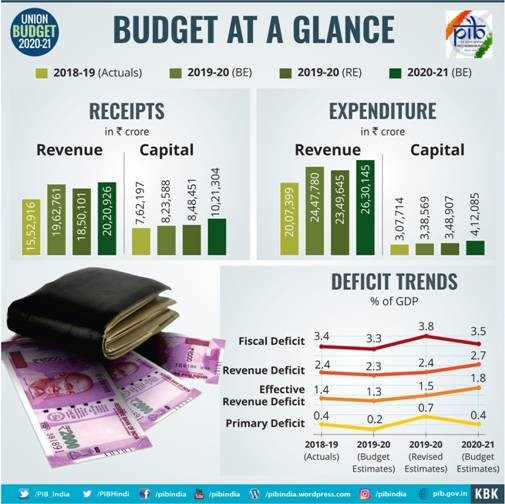
Three prominent themes of the Budget
- Aspirational India - better standards of living with access to health, education and better jobs for all sections of the society
- Economic Development for all - “Sabka Saath , Sabka Vikas , Sabka Vishwas”.
- Caring Society - both humane and compassionate; Antyodaya as an article of faith.
- Three broad themes are held together by:
- Corruption free, policy-driven Good Governance.
- Clean and sound financial sector.
- Ease of Living underlined by the three themes of Union Budget 2020-21.
Three components of Aspirational India
- Agriculture, Irrigation, and Rural Development
- Wellness, Water, and Sanitation
- Education and Skills
1.Sixteen Action Points for Agriculture, Irrigation and Rural Development
- Rs. 2.83 lakh crore to be allocated for the 16 Action Points:
- Rs. 1.60 lakh crore for Agriculture, Irrigation & allied activities.
- Rs. 1.23 lakh crore for Rural development & Panchayati Raj.
Agriculture Credit
- Rs. 15 lakh crore targets for Agriculture credit set for the year 2020-21.
Blue Economy
- Rs. 1 lakh crore fisheries’ exports to be achieved by 2024-25.
- 200 lakh tonnes fish production targeted by 2022-23.
Kisan Rail to be setup by Indian Railways through PPP:
- To build a seamless national cold supply chain for perishables (milk, meat, fish, etc.)
- Express and Freight trains to have refrigerated coaches.
Krishi Udaan to be launched by the Ministry of Civil Aviation:
- Both international and national routes to be covered.
- North-East and tribal districts to realize Improved value of agri-products.
- One-Product One-District for better marketing and export in the Horticulture sector.
Measures for organic, natural, and integrated farming
- Jaivik Kheti Portal – online national organic products market to be strengthened.
- Zero-Budget Natural Farming (mentioned in July 2019 Budget) to be included.
PM-KUSUM to be expanded
- 20 lakh farmers to be provided for setting up stand-alone solar pumps.
Village Storage Scheme
- Women, SHGs to regain their position as Dhaanya Lakshmi
Livestock:
- Doubling of milk processing capacity to 108 million MT from 53.5 million MT by 2025.
- Artificial insemination to be increased to 70% from the present 30%.
- MNREGS to be dovetailed to develop fodder farms.
- Foot and Mouth Disease, Brucellosis in cattle and Peste Des Petits ruminants (PPR) in sheep and goat to be eliminated by 2025.
2. Wellness, Water and Sanitation
- Rs. 69,000 crores allocated for overall Healthcare sector.
- Targeting diseases with an appropriately designed preventive regime using Machine Learning and AI.
- Jan Aushadhi Kendra Scheme to offer 2000 medicines and 300 surgical in all districts by 2024.
- TB Harega Desh Jeetega campaign launched - commitment to end Tuberculosis by 2025.
3. Education and Skills
- Rs. 99,300 crores for education sector and Rs. 3000 crores for skill development in 2020-21.
- New Education Policy to be announced soon.
- National Police University and National Forensic Science University proposed for policing science, forensic science, and cyber-forensics.
- Degree level full-fledged online education program by Top-100 institutions in the National Institutional Ranking Framework.
- Up to 1-year internship to fresh engineers to be provided by Urban Local Bodies.
- Budget proposes to attach a medical college to an existing district hospital in PPP mode.
- 150 higher educational institutions to start apprenticeship embedded degree/diploma courses by March 2021.
- External Commercial Borrowings and FDI to be enabled for education sector.
- Ind-SAT proposed for Asian and African countries as a part of Study in India program.
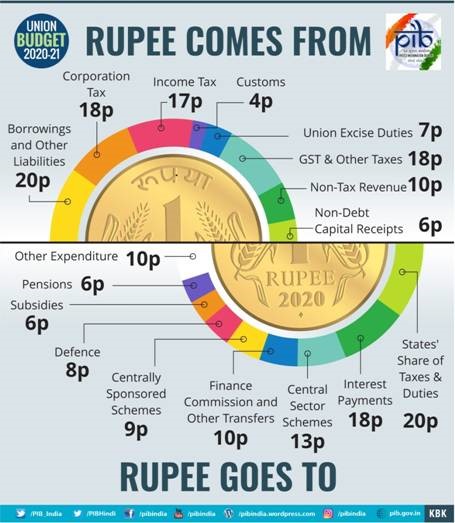
Economic Development
- Rs. 27,300 crores allocated for 2020-21 for development and promotion of Industry and Commerce.
- Investment Clearance Cell proposed to be set up:
- To provide “end to end” facilitation and support.
- To work through a portal.
- National Technical Textiles Mission to be set up
- New scheme NIRVIK to be launched to achieve higher export credit disbursement
- Turnover of Government e-Marketplace (GeM) proposed to be taken to Rs 3 lakh crore
- All Ministries to issue quality standard orders as per PM’s vision of “Zero Defect-Zero Effect” manufacturing.
Infrastructure
- Rs.100 lakh crore to be invested on infrastructure over the next 5 years.
- National Infrastructure Pipeline:
- Rs. 103 lakh crore worth projects; launched on 31st December 2019.
- A National Logistics Policy to be released soon
Highways
- Delhi-Mumbai Expressway and two other packages to be completed by 2023.
- Chennai-Bengaluru Expressway to be started.
- Proposed to monetise at least 12 lots of highway bundles of over 6000 Km before 2024.
Indian Railways
- More Tejas type trains to connect iconic tourist destinations.
- High speed train between Mumbai and Ahmedabad to be actively pursued.
- 148 km long Bengaluru Suburban transport project at a cost of Rs 18600 crore
- Indian Railways’ achievements:
- 550 Wi-fi facilities commissioned in as many stations.
- Zero unmanned crossings.
- 27000 Km of tracks to be electrified.
Ports & Water-ways
- Economic activity along river banks to be energised as per Prime Minister’s Arth Ganga concept.
Airports:
- 100 more airports to be developed by 2024 to support Udaan scheme.
- Air fleet number expected to go up from present 600 to 1200 during this time.
Electricity:
- “Smart” metering to be promoted.
Power:
- Rs.22, 000 crore proposed for power and renewable energy sector in 2020-21.
- Expansion of national gas grid from the present 16200 km to 27000 km proposed.
New Economy
- Fibre to the Home (FTTH) connections through Bharat-net to link 100,000-gram panchayats this year.
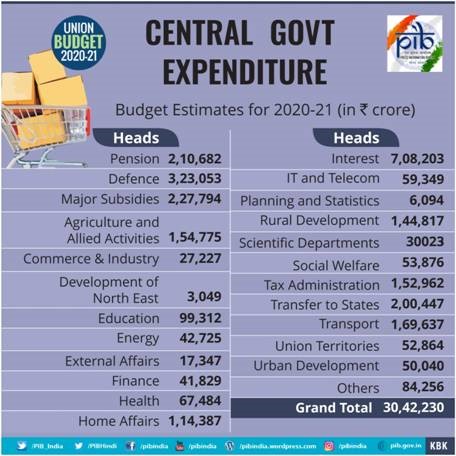
Caring Society
- Focus on:
- Women & child,
- Social Welfare;
- Culture and Tourism
- Allocation of Rs. 35,600 crores for nutrition-related programmes proposed for the FY2020-21.
- Rs.28, 600 crores proposed for women specific programs.
- Rs. 85, 000 crore proposed for 2020-21 for welfare of Scheduled Castes and Other Backward Classes.
- Rs. 53, 700 crores provided to further development and welfare of Scheduled Tribes.
- Enhanced allocation of Rs. 9,500 crores provided for 2020-21 for senior citizens and Divyang.
Culture & Tourism
- An Indian Institute of Heritage and Conservation under Ministry of Culture proposed; with the status of a deemed University.
- 5 archaeological sites to be developed as on-site Museums:
- Rakhigarhi (Haryana)
- Hastinapur (Uttar Pradesh)
- Shivsagar (Assam)
- Dholavira (Gujarat)
- Adichanallur (Tamil Nadu)
- Re-curation of the Indian Museum in Kolkata, announced by Prime Minister in January 2020.
- Museum on Numismatics and Trade to be located in the historic Old Mint building in Kolkata.
- Support for setting up of a Tribal Museum in Ranchi (Jharkhand).
- Maritime museum to be set up at Lothal- the Harrapan age maritime site near Ahmedabad, by Ministry of Shipping.
Environment & Climate Change
- PM launched Coalition for Disaster Resilient Infrastructure (CDRI) with Secretariat in Delhi.
- Second such international initiative after International Solar Alliance.
Governance
- Taxpayer Charter to be enshrined in the Statute will bring fairness and efficiency in tax administration.
- Major reforms in recruitment to Non-Gazetted posts in Government and Public sector banks:
- An independent, professional and specialist National Recruitment Agency (NRA) for conducting a computer-based online Common Eligibility Test for recruitment.
- A test-centre in every district.
- New National Policy on Official Statistics to promote use of latest technologies including AI.
- A sum of Rs. 100 crores allocated to begin the preparations for G20 presidency to be hosted in India in the year 2022.
Financial Sector
- Reforms accomplished in PSBs:
- 10 banks consolidated into 4.
- Rs. 3,50,000 crore capital infused.
- Deposit Insurance and Credit Guarantee Corporation (DICGC) permitted to increase Deposit Insurance Coverage to Rs. 5 lakhs from Rs.1 lakh per depositor.
- Government to sell its balance holding in IDBI Bank to private, retail and institutional investors through the stock exchange.
Financial Market
- FPI limit in corporate bonds increased to 15% from 9% of its outstanding stock
Disinvestment
- Government to sell a part of its holding in LIC by way of Initial Public Offer (IPO).
- XV Finance Commission (FC):
- XV Finance Commission has given its first report for FY2020-21
- Its final report for five years beginning 2021-22 to be submitted during the latter part of the year.
GST Compensation Fund:
- Balances due out of collection of the years 2016-17 and 2017-18 to be transferred to the Fund, in two instalments.
Economy in Numbers
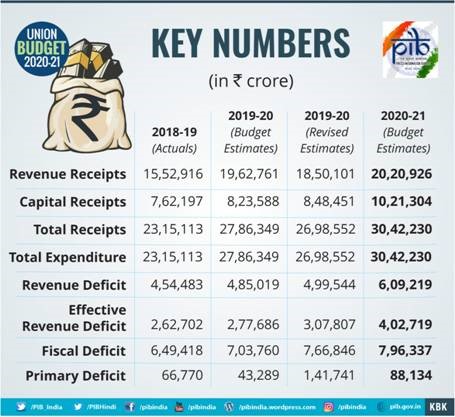
- For the FY 2019-20:
- Revised Estimates of Expenditure: at Rs.26.99 lakh crore
- Revised Estimates of Receipts: estimated at Rs.19.32 lakh crore.
- For the FY 2020-21:
- Nominal growth of GDP estimated at 10%.
- Receipts: estimated at Rs.22.46 lakh cr
- Expenditure: at Rs.30.42 lakh cr.
- Fiscal deficit of 3.8% estimated in RE 2019-20 and 3.5% for BE 2020-21.
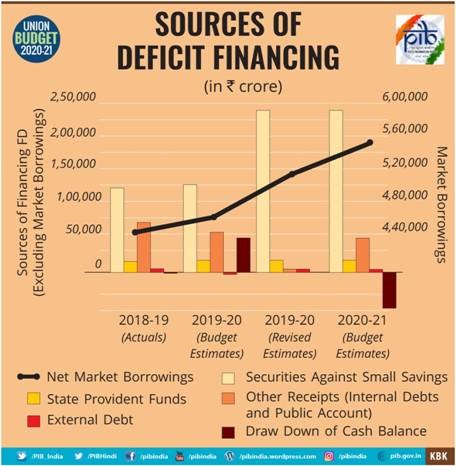
- Market borrowings:
- Net market borrowings: Rs.4.99 lakh crore for 2019-20 and Rs.5.36 lakh crore for 2020-21.
Direct Tax
|
Taxable Income Slab (Rs.) |
Existing tax rates |
New tax rates |
|
0-2.5 Lakh |
Exempt |
Exempt |
|
2.5-5 Lakh |
5% |
5% |
|
5-7.5 Lakh |
20% |
10% |
|
7.5-10 Lakh |
20% |
15% |
|
10-12.5 Lakh |
30% |
20% |
|
12.5-15 Lakh |
30% |
25% |
|
Above 15 Lakh |
30% |
30% |
Corporate Tax:
- Tax rate of 15% extended to new electricity generation companies.
- Indian corporate tax rates now amongst the lowest in the world.
Start-ups:
- Start-ups with turnover up to Rs. 100 crores to enjoy 100% deduction for 3 consecutive assessment years out of 10 years.
Cooperatives:
- Cooperative societies exempted from Alternate Minimum Tax (AMT) just like Companies are exempted from the Minimum Alternate Tax (MAT).
Tax Facilitation Measures
- Instant PAN to be allotted online through Aadhaar.
- Vivad Se Vishwas’ scheme, with a deadline of 30th June, 2020, to reduce litigations in direct taxes
- Faceless appeals to be enabled by amending the Income Tax Act.
Indirect Tax
- Excise duty proposed to be raised on Cigarettes and other tobacco product
- Anti-dumping duty on PTA abolished to benefit the textile sector
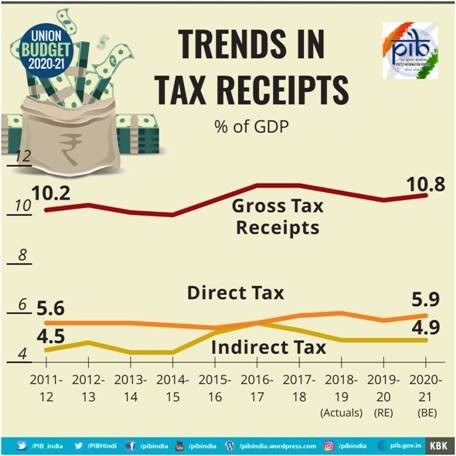
Unprecedented Milestones and Achievements of Indian Economy
- India now the fifth largest economy of the world.
- 7.4% average growth clocked during 2014-19 with inflation averaging around 4.5%.
- 271 million people raised out of poverty during 2006-16.
- India’s Foreign Direct Investment elevated to US$ 284 billion during 2014-19 from US$ 190 billion during 2009-14.
- Central Government debt reduced to 48.7% of GDP (March 2019) from 52.2% (March 2014).
Future Aim for sustaining India’s unique global leadership, driven by Digital Revolution
- Seamless delivery of services through Digital Governance.
- Improvement in physical quality of life through National Infrastructure Pipeline.
- Risk mitigation through Disaster Resilience.
- Social security through Pension and Insurance penetration.
ó ó ó ó ó ó ó ó ó ó


